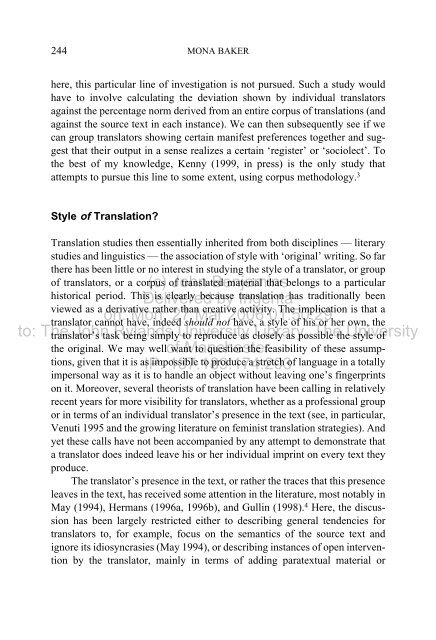Towards a Methodology for Investigating the Style of a Literary ...
Towards a Methodology for Investigating the Style of a Literary ...
Towards a Methodology for Investigating the Style of a Literary ...
You also want an ePaper? Increase the reach of your titles
YUMPU automatically turns print PDFs into web optimized ePapers that Google loves.
244 MONA BAKER<br />
here, this particular line <strong>of</strong> investigation is not pursued. Such a study would<br />
have to involve calculating <strong>the</strong> deviation shown by individual translators<br />
against <strong>the</strong> percentage norm derived from an entire corpus <strong>of</strong> translations (and<br />
against <strong>the</strong> source text in each instance). We can <strong>the</strong>n subsequently see if we<br />
can group translators showing certain manifest preferences toge<strong>the</strong>r and suggest<br />
that <strong>the</strong>ir output in a sense realizes a certain ‘register’ or ‘sociolect’. To<br />
<strong>the</strong> best <strong>of</strong> my knowledge, Kenny (1999, in press) is <strong>the</strong> only study that<br />
attempts to pursue this line to some extent, using corpus methodology. 3<br />
<strong>Style</strong> <strong>of</strong> Translation?<br />
Translation studies <strong>the</strong>n essentially inherited from both disciplines — literary<br />
studies and linguistics — <strong>the</strong> association <strong>of</strong> style with ‘original’ writing. So far<br />
<strong>the</strong>re has been little or no interest in studying <strong>the</strong> style <strong>of</strong> a translator, or group<br />
<strong>of</strong> translators, or a corpus (c) <strong>of</strong> John translated Benjamins<br />
material that belongs to a particular<br />
historical period. This Delivered is clearly because by Ingenta<br />
translation has traditionally been<br />
viewed as a derivative ra<strong>the</strong>r than creative activity. The implication is that a<br />
on: Mon, 27 Mar 2006 01:50:29<br />
translator cannot have, indeed should not have, a style <strong>of</strong> his or her own, <strong>the</strong><br />
to: The translator’s John task Rylands being simply University to reproduce as closely Library, as possible The <strong>the</strong> University<br />
style <strong>of</strong><br />
<strong>the</strong> original. We may well <strong>of</strong> want Manchester<br />
to question <strong>the</strong> feasibility <strong>of</strong> <strong>the</strong>se assumptions,<br />
given that it is as IP: impossible 137.189.174.203<br />
to produce a stretch <strong>of</strong> language in a totally<br />
impersonal way as it is to handle an object without leaving one’s fingerprints<br />
on it. Moreover, several <strong>the</strong>orists <strong>of</strong> translation have been calling in relatively<br />
recent years <strong>for</strong> more visibility <strong>for</strong> translators, whe<strong>the</strong>r as a pr<strong>of</strong>essional group<br />
or in terms <strong>of</strong> an individual translator’s presence in <strong>the</strong> text (see, in particular,<br />
Venuti 1995 and <strong>the</strong> growing literature on feminist translation strategies). And<br />
yet <strong>the</strong>se calls have not been accompanied by any attempt to demonstrate that<br />
a translator does indeed leave his or her individual imprint on every text <strong>the</strong>y<br />
produce.<br />
The translator’s presence in <strong>the</strong> text, or ra<strong>the</strong>r <strong>the</strong> traces that this presence<br />
leaves in <strong>the</strong> text, has received some attention in <strong>the</strong> literature, most notably in<br />
May (1994), Hermans (1996a, 1996b), and Gullin (1998). 4 Here, <strong>the</strong> discussion<br />
has been largely restricted ei<strong>the</strong>r to describing general tendencies <strong>for</strong><br />
translators to, <strong>for</strong> example, focus on <strong>the</strong> semantics <strong>of</strong> <strong>the</strong> source text and<br />
ignore its idiosyncrasies (May 1994), or describing instances <strong>of</strong> open intervention<br />
by <strong>the</strong> translator, mainly in terms <strong>of</strong> adding paratextual material or



